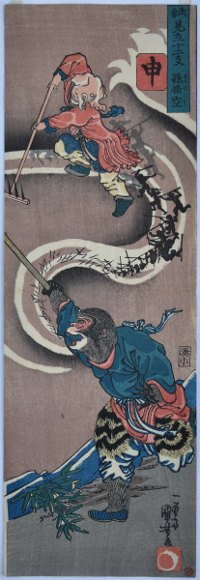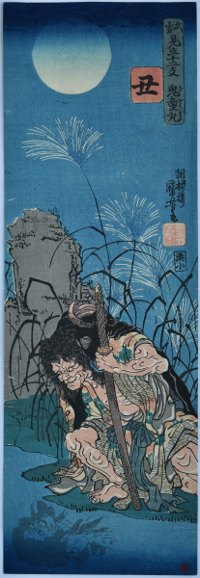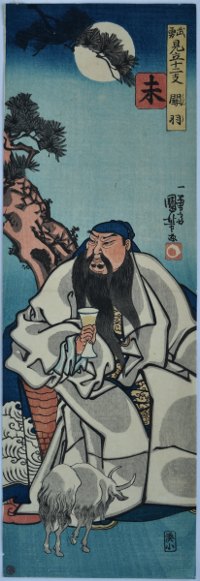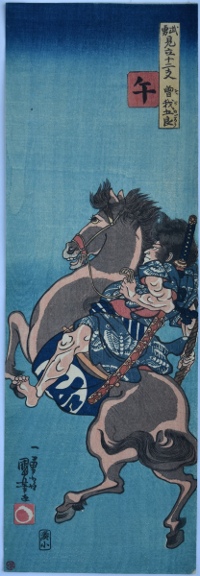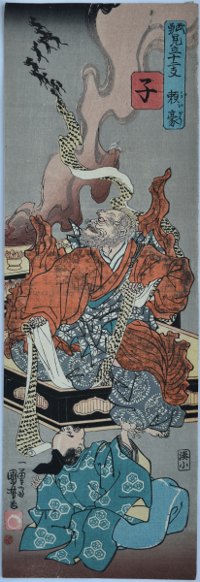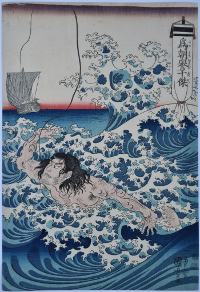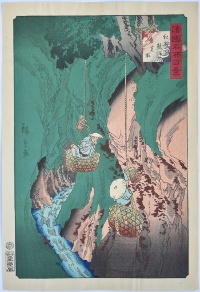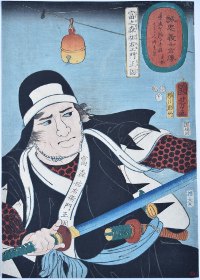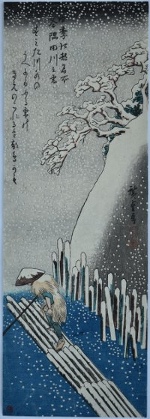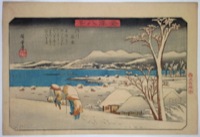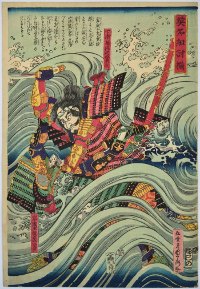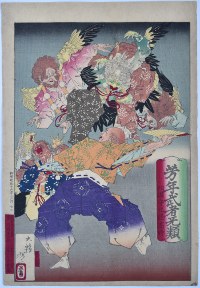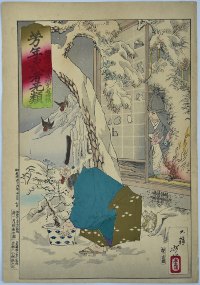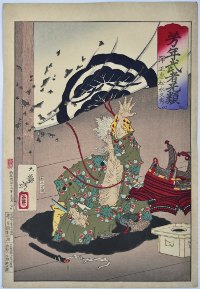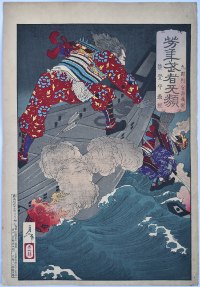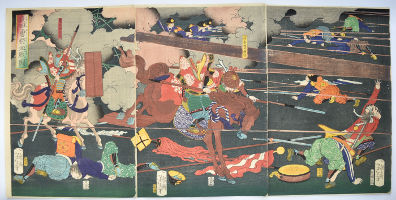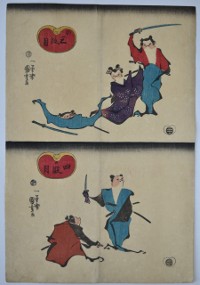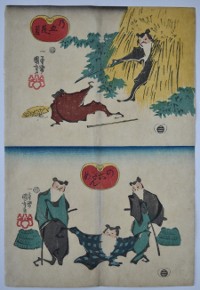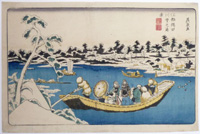/category/archive/page/12/
Utagawa KUNIYOSHI (1797-1861)
Click here to view image full size.
Monkey from a chu-tanzaku set of twelve prints Buyu mitate junishi, “Chosen Heroes for the Twelve Signs.” Based on the Chinese zodiac system of twelve animals. Shows the Monkey King, Songoku (Sun Wu K’ung) conjuring up an army of monkeys to attack his enemy the pig. Published by Minatoya Kohei, c. 1840.
Very good impression and colour. Minimal trimming, otherwise very good condition. Signed Ichiyusai Kuniyoshi ga.
Status: Sold
Utagawa KUNIYOSHI (1797-1861)
Click here to view image full size.
Ox from a chu-tanzaku set of twelve prints Buyu mitate junishi, “Chosen Heroes for the Twelve Signs.” Based on the Chinese zodiac system of twelve animals. Shows the robber Kidomaru under a buffalo hide looking at his reflection in water while attempting to ambush and kill Raiko. Published by Minatoya Kohei, c. 1840.
Very good impression and colour. Minimal trimming, otherwise very good condition. Signed Ichiyusai Kuniyoshi ga.
Status: Sold
Utagawa KUNIYOSHI (1797-1861)
Click here to view image full size.
Goat from a chu-tanzaku set of twelve prints Buyu mitate junishi, “Chosen Heroes for the Twelve Signs.” Based on the Chinese zodiac system of twelve animals. Shows the Chinese hero Kwanu (Kuan Yu) seated drinking under a pine tree with a goat. Published by Minatoya Kohei, c. 1840.
Very good impression and colour. Minimal trimming, otherwise very good condition. Signed Ichiyusai Kuniyoshi ga.
Status: Sold
Utagawa KUNIYOSHI (1797-1861)
Click here to view image full size.
Horse from a chu-tanzaku set of twelve prints Buyu mitate junishi, “Chosen Heroes for the Twelve Signs.” Based on the Chinese zodiac system of twelve animals. Shows Soga Goro (Tokimune) galloping from Hakone to Mount Fuji to meet his brother Juro and fulfill their revenge in the course of Yoritomo’s great hunting party in 1193. Published by Minatoya Kohei, c. 1840.
Very good impression and colour. Minimal trimming, otherwise very good condition. Signed Ichiyusai Kuniyoshi ga.
Status: Sold
Utagawa KUNIYOSHI (1797-1861)
Click here to view image full size.
Rat from a chu-tanzaku set of twelve prints Buyu mitate junishi, “Chosen Heroes for the Twelve Signs.” Based on the Chinese zodiac system of twelve animals. Shows Raigo Ajari at the Onjoji monastery, Miidera, turning the Buddhist scriptures into rats. Oye no Masafusa looks on in dismay. Published by Minatoya Kohei, c. 1840.
Very good impression and colour. Minimal trimming, otherwise very good condition. Signed Ichiyusai Kuniyoshi ga.
Status: Sold
Utagawa KUNIYOSHI (1797-1861)
Click here to view image full size.
Shows Tametomo’s faithful retainer Kiheiji who is left behind by mistake when Tametomo sails for Japan from the Ryukyu Islands. He throws a weighted rope the immense distance to the ship and is hauled in. The best design from Tametomo homare no jikketsu, “Ten Famous Excellences of Tametomo.” A set of ten prints published by Aritaya Seiyemon, c. 1848-51.
Fine impression and colour. Slight trimming, otherwise very good condition. Signed Ichiyusai Kuniyoshi ga.
Status: Sold
Utagawa HIROSHIGE II (1826-1869)
Click here to view image full size.
Gathering iwatake, rock tripe or rock mushrooms in Kii Province. The common name for various edible lichens that grow on cliffs. The gatherers used precarious baskets that were hauled up and down the cliff face to collect them. Kishu Kumano iwatake tori from Shokoku meisho hyakkei, “One Hundred Views of Famous Places in the Provinces.” Published by Uoyei 1859-1861 (this being 1860). A fascinating print.
Very fine impression of the first edition. Fine colour and condition. Signed Hiroshige ga.
Status: Sold
Utagawa KUNIYOSHI (1797-1861)
Click here to view image full size.
Tominomori Sukeemon Masakata, one of the famed Forty-seven Ronin, sword drawn, during the famous night attack on the house of Kono Moronao. The hanging bell, above, was an early intruder alarm system. (Interestingly, it’s also said that squeaks were deliberately incorporated into wooden floors for the same reason.) This unusual western-style set is also rare in having the printer’s name, Ohisa Daiihitsu, on five (including this) of the twelve prints in the set. Published by Sumiyoshiya Masagoro, 1852.
Fine impression and colour. Slight trimming, otherwise very good condition. Signed Kuniyoshi ga.
Status: Sold
Ichiryusai HIROSHIGE (1797-1858)
Click here to view image full size.
An extremely rare chu-tanzaku, Fuyu Sumidagawa no yuki, “Winter Snow on the Sumida River.” From a set Shiki Edo meisho, “Famous Places in Edo in the Four Seasons.” A lone figure in straw cape and large hat poles a log raft down the Sumida river in heavy snow. Published by Kawasho c. 1834. There are a number of states of this design known: As here (probably the earliest) with publisher’s seal and kiwame seal; with kiwame only; and without either. There are also extremely deceiving copies of this print. Provenance: Ex Le Veel collection, sold by Ader Picard Tajan, Paris, 2nd sale, 24/10/1980, lot 114, p. 50.
Very good impression, colour and condition. Signed Hiroshige ga.
Status: Sold
Ichiryusai HIROSHIGE ( 1797-1858 )
Click here to view image full size.
“Evening Snow at Uchikawa”, Uchikawa bosetsu from the early set Kanazawa hakkei, “Eight Views in Kanazawa” published by Koshimuraya Heisuke, c 1835-6. This is an extremely rare and fine set and examples in good condition are very difficult to find. Each print contains a classical 31-syllable waka poem above. Kanazawa sits on the Sea of Japan bordered by the Japan Alps. One of Hiroshige’s finest compositions.
Fine impression and colour. Small restored wormhole bottom edge left, otherwise very good condition.Large margins. Signed Hiroshige ga.
Status: Sold
Utagawa SADAHIDE (1807-1873)
Click here to view image full size.
Iwanari Chikara no Suke and Shimozu Gonnai struggling in the water from Eimei kumiuchi soroi, “A Series of Famous Fighting Warriors.” Published by Moriya Jihei, 1865.
Fine impression, colour and condition. Signed Gountei Sadahide ga.
Status: Sold
Taiso YOSHITOSHI (1839-1892)
Click here to view image full size.
Sagaminokami Hojo Takatoki warding off a group of tengu with his fan. From the fine set Yoshitoshi mushaburui, “Yoshitoshi’s Courageous Warriors.” Published by Kobayashi, 1883-1886 (this being 1883).
Fine impression and colour. Light toning, otherwise fine condition. This is the first edition. There are a number of later states and the set was republished by Tsunajima in 1886.
Status: Sold
Taiso YOSHITOSHI (1839-1892)
Click here to view image full size.
Sano Genzaemon cutting his potted trees to warn Hojo Tokiyori. From the fine set Yoshitoshi mushaburui, “Yoshitoshi’s Courageous Warriors.” Published by Kobayashi, 1883-1886 (this being 1883).
Fine impression and colour. Light toning, otherwise fine condition. This is the first edition. There are a number of later states and the set was republished by Tsunajima in 1886.
Status: Sold
Taiso YOSHITOSHI (1839-1892)
Click here to view image full size.
Danjo Matsunaga Hisahide preparing to commit suicide. From the fine set Yoshitoshi mushaburui, “Yoshitoshi’s Courageous Warriors.” Published by Kobayashi, 1883-1886 (this being 1883).
Fine impression and colour. Light toning, otherwise fine condition. This is the first edition. There are a number of later states and the set was republished by Tsunajima in 1886.
Status: Sold
Taiso YOSHITOSHI (1839-1892)
Click here to view image full size.
Kuro Hangan Yoshitsune and Notonokami Noritsune fighting on a ship’s prow. From the fine set Yoshitoshi mushaburui, “Yoshitoshi’s Courageous Warriors.” Published by Kobayashi, 1883-1886 (this being 1886).
Fine impression and colour. Light toning, otherwise fine condition. Early edition. There are a number of later states and the set was republished by Tsunajima in 1886.
Status: Sold
Tsukioka YOSHITOSHI (1839-1892)
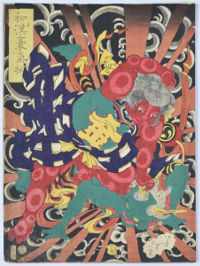
Click here to view image full size.
A chuban print from a set Wakan goki zoroi, “Valour in China and Japan.” Shows Kintaro about to deliver a blow to the Thunder God Raijin (the God of thunder and lightning – a Japanese Thor). Published by Daisada, 1868. A rare set.
Fine impression, colour and condition. Signed Ikkaisai Yoshitoshi hitsu.
Status: Sold
Hishikawa SORI (Active 1797-c.1813)
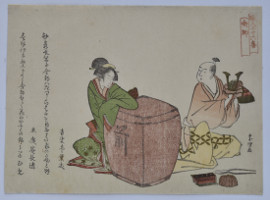
Click here to view image full size.
A samurai helmet maker (kabuto) from a series of surimono Shokunin sanjurokuban, “Thirty-six Poets as Craftsmen.” Issued for the Asakusagawa Club in 1802. Hand-stamped series title top right. Sori was a pupil of Hokusai originally called Soji with Hokusai passing on the name to him. Shows a beauty leaning on a cabinet that holds armour. On the right the craftsman holding a helmet. The set was reissued in a slightly different format in 1803.
Fine impression, colour and condition with touches of gold. Signed Sori ga.
Status: Sold
Utagawa KUNIYOSHI (1797-1861)
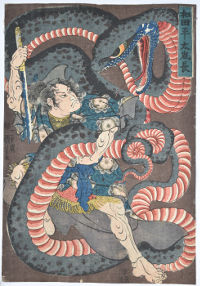
Click here to view image full size.
Wada Heita Tanenaga (1182-1213), short sword in hand, struggling with a giant python. He was a renowned archer and retainer of Minamoto no Yoriie. Various stories tell of how he came across the python in a cave or saved a village from its carnivorous attacks. From an untitled early set published by Yamashiroya Heisuke, c. 1845. Robinson S1f.8. A striking design and rare.
Very good impression and colour. Slight trimming, otherwise very good condition. Signed Ichiyusai Kuniyoshi ga.
Status: Sold
Utagawa KUNIYOSHI (1797-1861)
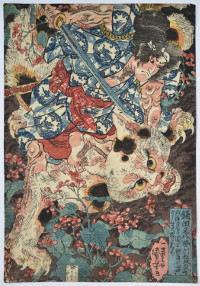
Click here to view image full size.
Kamada Matahachi of Matsusaka in Ise Province killing a monstrous cat. These mountain cats – nekomata – were reputed to eat humans. Published by Tsutaya Kichizo, c. 1840. Robinson S1e.3. A wonderful and rare design.
Very good impression and colour. Repair bottom right corner and slight trimming, otherwise good condition. Signed Ichiyusai Kuniyoshi ga.
Status: Sold
Utagawa KUNIYOSHI (1797-1861)
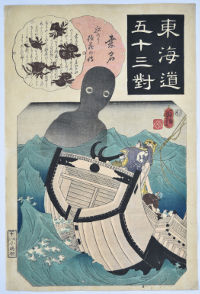
Click here to view image full size.
The apparition of the Sea Monk, Umibozu, looming above the sailor Kawanaya Tokuzo. The best design from Tokaido gojusan tsui, Station 41, Kuwana. The legend has it that Tokuzo, against the advice of his peers, went to sea on the last day of the year. He subsequently experienced huge seas and the monster who demanded to know what was the most horrible thing he knew. He replied that his profession was the most horrid. Satisfied, the creature descended into the Stygian gloom and the storm abated. Published by Kojimaya Jubei, c. 1845. Illustrated in Robinson, Kuniyoshi, HMSO, 1961, no. 49.
Fine early impression with the light blue on the sea. Very good colour and condition. Signed Ichiyusai Kuniyoshi ga.
Status: Sold
Utagawa KUNISADA (1786-1864)
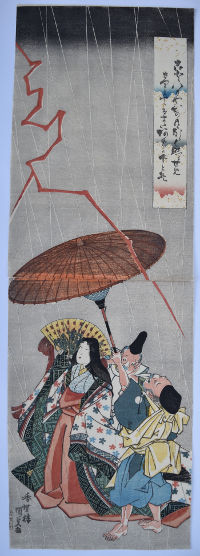
Click here to view image full size.
A vertical diptych showing the famous waka poet Ono no Komachi (c. 1825-c. 900) being sheltered by attendants from an upcoming storm. She is famous for composing a poem and praying for rain at the behest of the Emperor Junna during a period of drought across Japan. The poem she composed, shown above, she threw into the pond of the Shinsen-en Garden. It started raining after three days . The poem reads: Though it is called the “land beneath the sun [Japan]” surely it must rain here. Published by Kikakudo, c. 1833-35. Rare.
Fine impression, colour and condition. Signed Kochoro Kunisada ga.
Status: Sold
Utagawa HIROSHIGE (1797-1858) and Utagawa KUNISADA (1786-1864)
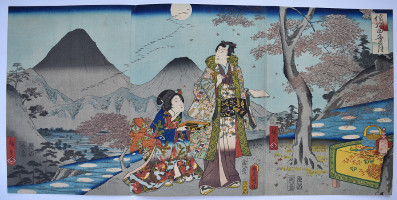
Click here to view image full size.
A triptych Shinshu Sarashina tagoro no tsuki, “The Moon Reflected in the Rice Fields at Sarashina, Shinano Province.” Shows Mitsuuji, the romantic hero of the Inaka Genji (“A Rustic Genji”), admiring the multiple views of the moon reflected in the paddy-fields and about to compose a poem. On the left, Mount Kyodai. This phenomenon was greatly admired and pilgrimages were made to view it. There was a plethora of these Genji parody prints in the 1850s following two popular Kabuki plays and Hiroshige and Kunisada collaborated on a number of such triptychs. Interestingly, this design has a date seal for 3/1861 making it probably the last and based on an existing collaborative hanshita-e. Published by Moriya Jihei. Rare.
Superb impression and colour. Slightly trimmed round; sheets connected and album backing, otherwise very good condition. Signed Hiroshige ga and Toyokuni ga.
Status: Sold
Utagawa KUNIYOSHI (1797-1861)
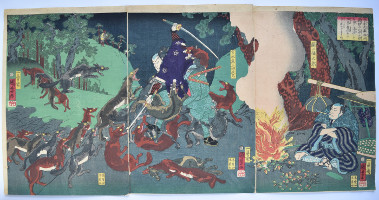
Click here to view image full size.
A triptych showing Miyamoto Mushashi (c. 1584-1645) fighting a pack of wolves in the mountains of Hakone watched by Sekiguchi Yataro seated beside a fire. Musashi was a renowned double-bladed swordsman (as seen here) and is considered the sword-saint of Japan. Published by Kiya Sojiro, 4/1861 and is probably Kuniyoshi’s last print.
Very good impression and colour. Slight creasing, otherwise very good condition. Signed Ichiyusai Kuniyoshi ga.
Status: Sold
Yashima GAKUTEI (1786 ?-1868)
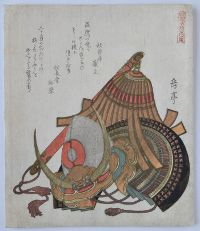
Click here to view image full size.
Best known for his surimono although he produced fine paintings, some good landscapes and was also known as a poet. A surimono, one of a set of two on the martial arts of Japan and China, this obviously being Japan: Wakan butoku no uchi. Shows a helmet with a demon’s head and a red-lacquered baton with leather strips. These are usually the accoutrements of the famous general Kato Kiyomasa (1562-1611). Two poems by Shusetsutei Kuranushi and Shuchodo Monoyana. Issued c. 1820. Three collector’s seals au verso including Kunsthalle Bremen. Rare.
Very fine impression and colour with extensive gold, silver and bronze. Light edge tape on back, otherwise very good condition. Signed Gakutei.
Status: Sold
Tsukioka YOSHITOSHI (1839-1892)
Click here to view image full size.
Click here to view image full size.
A complete hexaptych (six-sheet) design comprising two triptychs: Kawanakajima okassen no zu, “The Great Battle of Kawanakajima,” published by Tsujibun, 6/1866 and Takeda yusho kessen no zu, “The Bloody Battle of the Brave Generals of the Takeda Clan,” published by Tsujibun, 6/1867. The great battles of Kawanakajima took place between 1553 and 1564 between the daimyos Takeda Shingen (1521-1573) and Uesugi Kenshin (1530-1578). Starting as more skirmishes than all out warfare they ended up with a fourth battle where Kenshin is estimated to have had 72% casualties and Shingen 62%. Rare complete.
Fine impression, colour and condition. Signed Ikkaisai Yoshitoshi hitsu.
Status: Sold
Yashima GAKUTEI (1786 ?-1868)
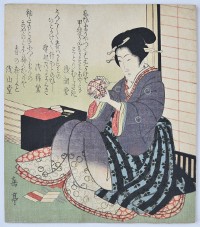
Click here to view image full size.
Best known for his surimono although he produced fine paintings, some good landscapes and was also known as a poet. A surimono showing a young mother making a temari ball. This form of folk art arrived from China in the 7th c. The balls were given to children on New Year’s day. Their production evolved and became more intricate with time, some having bells or rice placed in them so they became audible or had a mother’s wish secreted inside. A beautiful and extremely rare surimono: At the moment I cannot locate another impression.
Very fine impression. Fine colour. Slight vertical crease strengthened au verso, otherwise very good condition. Signed Gakutei.
Status: Sold
Utagawa HIROSHIGE (1797-1858)
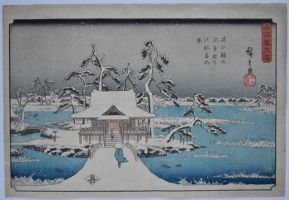
Click here to view image full size.
A snow scene showing the Inokashira Benten Shrine and Inokashira Pond, Inokashira no ike Benzaiten no Yashiro no kei from a set Meisho setsugekka, “Famous Places of Snow, Moon and Flowers.” The pond was originally built to supply water for Edo. This is the first edition published by Zen c. 1842; it was subsequently republished by Maruya Jinpachi and there are further late editions without publisher’s seal, a different seal beneath Hiroshige’s signature and with a recut block giving larger snowflakes.
Fine impression and colour. Minor margin soil, otherwise very good condition. Signed Hiroshige ga.
Status: Sold
Utagawa HIROSHIGE (1797-1858)
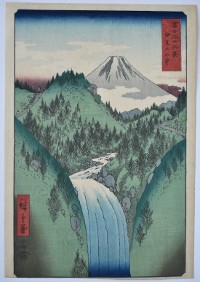
Click here to view image full size.
A view of the beautiful peninsula of Izu, Izu no sanchu, “In the Mountains of Izu Province” from Fuji sanjurokkei, the “Thirty-six Views of Fuji.” The set published by Tsutaya Kichizo, 1858. This area is about 100 km southwest of Tokyo and a popular place to visit.
Very fine impression and colour. Trimmed close bottom left, otherwise fine condition. Signed Hiroshige ga.
Status: Sold
Utagawa HIROSHIGE (1797-1858)
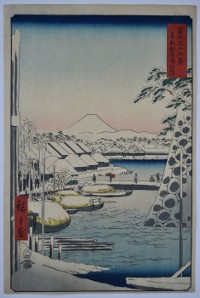
Click here to view image full size.
Sukiya embankment in snow, Toto Sukiya-gashi, from Fuji sanjurokkei, the “Thirty-six Views of Fuji.” The set published by Tsutaya Kichizo, 1858. The rampart on the inner side of the moat of Edo Castle on the right. Figures cross a bridge leading to Sukiya Gate. In the distance the long outer walls of the main residence of the Nabeshima Clan of Saga. Fuji on the horizon.
Very fine impression and colour. A very small repaired wormhole in top right margin, otherwise fine condition. Signed Hiroshige ga.
Status: Sold
Utagawa HIROSHIGE (1797-1858)
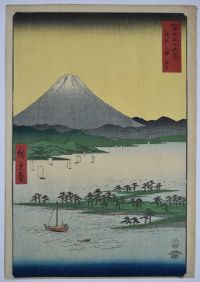
Click here to view image full size.
Suruga Miho no Matsubara, “Miho no Matsubara in Suruga Province” from Fuji sanjurokkei, the “Thirty-six Views of Fuji.” The set published by Tsutaya Kichizo, 1858. Shows the renowned pine trees with a majestic Fuji below a yellow sky. Many of these pines are now hundreds of years old.
Very fine impression, colour and condition. Signed Hiroshige ga.
Status: Sold
Utagawa HIROSHIGE (1797-1858)
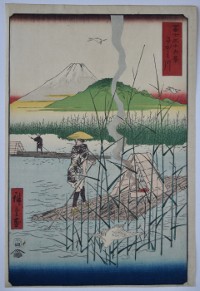
Click here to view image full size.
Men punting rafts on the Sagami River from Fuji sanjurokkei, the “Thirty-six Views of Fuji.” The set published by Tsutaya Kichizo, 1858.This print was included in the background of the famous 1887 portrait of Pere Tanguy by Vincent Van Gogh. The river was sometimes referred to as the Ayu River because of the (then) abundance of sweetwater fish (ayu).
Very fine impression, colour and condition. Signed Hiroshige ga.
Status: Sold
Utagawa KUNISADA (1786-1864)
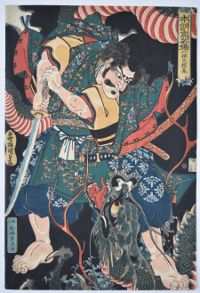
Click here to view image full size.
An early warrior print showing Rokuson Okeigi (Minamoto no Tsunemoto [894-961]) battling a giant dragon. From a set Honcho komei kagami, “A Mirror of Our Country’s Renown Heroes” published by Joshuya Kinzo, c. 1835.
Fine impression and colour. Slight trimming, otherwise very good condition. Signed Kocho Kunisada ga.
Status: Sold
Utagawa KUNIYOSHI (1797-1861)
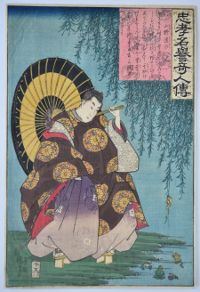
Click here to view image full size.
Ono no Tofu (Michikaze) in court robes learns perserverance by watching the efforts of a frog to climb a branch of a willow tree. From a set Chuko meiyo kijin den, “Stories of Remarkable Persons of Loyalty and High Reputation.” Published c. 1845 by Enshuya Matabei. Robinson S35.10.
Fine impression and colour. Very good condition. Signed Ichiyusai Kuniyoshi ga.
Status: Sold
Utagawa KUNIYOSHI (1797-1861)
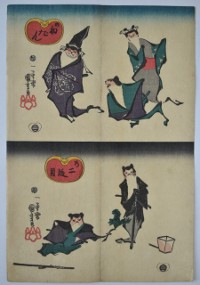
Click here to view image full size.
Six uncut double chuban sheets from a bat Chushingura set. Acts 1 to 6: Shodanme; Nidanme; Sandanme; Yodanme; Godanme; Rokudanme. Published c. 1847 by Ibaya Senzaburo. Of the utmost rarity: I cannot, at the moment, locate other examples from this set.
Fine impressions and colour. Vertical centre folds, otherwise fine condition. Signed Ichiyusai Kuniyoshi ga on each sheet.
Status: Sold
Taiso YOSHITOSHI (1839-1892)
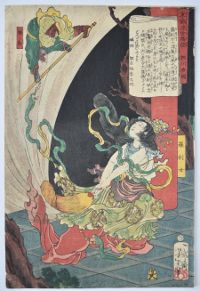
Click here to view image full size.
A design from a set Azuma nishiki ukiyo kodan, “Rough Tales of the Floating World.” Various publishers between 1867 -1868, here Omi-Kyu in 1868. The prints interpret stories told by various well known storytellers, in this case Momokawa Enkoku. Shows the Monkey King (Son Goku) being catapulted into the air by the force of the large palm fan of Princess Iron Fan. (The fan was capable of creating strong winds and putting out fires.) She was a Rasetsunyo, a female protector of Buddhism. A comparatively rare set.
Very good impression, colour and condition. Signed Ikkaisai Yoshitoshi hitsu.
Status: Sold
Taiso YOSHITOSHI (1839-1892)
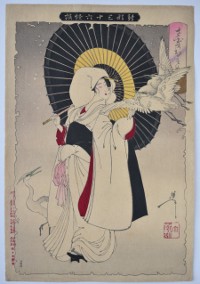
Click here to view image full size.
Shows the famous Heron Maiden. There are different versions of this story but the most common tells how a young man finds an injured heron. He nurses it back to health and releases it. Some time later a beautiful young woman appears in his village. He falls in love and they marry. She makes fine brocade which they sell, but she does not allow him to see her making it. Tempted he secretly views her only to discover she is the heron. This is the end of their marriage and the heron flies away. From a set Shingata sanjurokkaisen, “New Forms of Thirty-six Ghosts,” sub-title: Sagi musume. The set published by Sasaki between 1889- 1892 (this being 1889). This is the first edition.
Very fine impression, colour and condition. Signed Yoshitoshi.
Status: Sold
Taiso YOSHITOSHI (1839-1892)
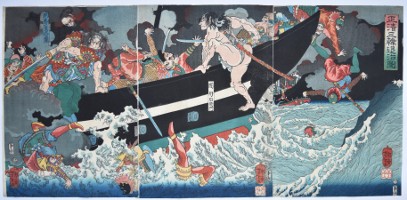
Click here to view image full size.
A triptych Masakiyo sankan taiji no zu, “A Picture of Masakiyo Conquering Korea.” The design purports to show Kato Kiyomasa (1562-1611) invading Korea, but is probably a reference to the English bombardment of Kagoshima harbour in 1863. There is further confusion by the Koreans being dressed in medieval European costumes. Published by Yamaguchiya in 1864. There is a history in ukiyo-e of commenting on current – but sensitive – events, but setting them in the distant past to avoid censorship.
Fine early impression with burnishing on boat. Fine colour. Slight creases along right edge of sheets, otherwise very good condition. Signed Ikkaisai Yoshitoshi ga.
Status: Sold
Utagawa YOSHICHIKA (Fl. c. 1850-1868)
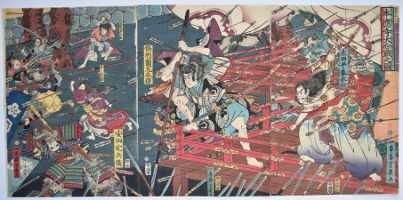
Click here to view image full size.
A triptych showing the famous battle at Honno-ji Temple, Nakagyo-ku, Kyoto in 1582. Honno-ji dai gassen no zu. The Daimyo Oda Nobunaga was at the height of his powers but came under attack from his treacherous samurai general Akechi Mitsuhide and the Oda forces. Nobunaga, his wife Noh and his retainers battle valiantly but he is forced to commit suicide. Published by Fujiokaya Keijiro, 1861.
Very fine impression, colour and condition. Signed Ikkesisai Yoshichika ga.
Status: Sold
Utagawa TOYOKUNI I (1769-1825)
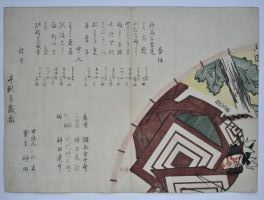
Click here to view image full size.
A large surimono which shows Danjuro VII in Shibaraku on a fan on the right. He did, in fact, perform Shibaraku in the 11th month kaomise performance at the Morita-za theatre in 1812 (which fits the style of Toyokuni’s signature). However, the rest of the design appears to be a program for a dance recital with the names of dances and below the names of Nagauta School musicians and Hayashi percussionists. This makes the exact reason for the print difficult to determine. Extremely rare: Possibly the only known impression.
Very good impression and colour. Slight surface soil and vertical fold (as usual), otherwise very good condition. Signed Toyokuni ga.
Status: Sold
Keisai EISEN (1790-1848)
Click here to view image full size.
The Sumida River in snow from a series of views of the Koto Ward of Edo. This area was bounded by the Sumida to the west and the Arakawa to the east. Shows travellers being ferried across the river. No publisher or date given.
Very good impression, colour and condition.
Status: Sold
